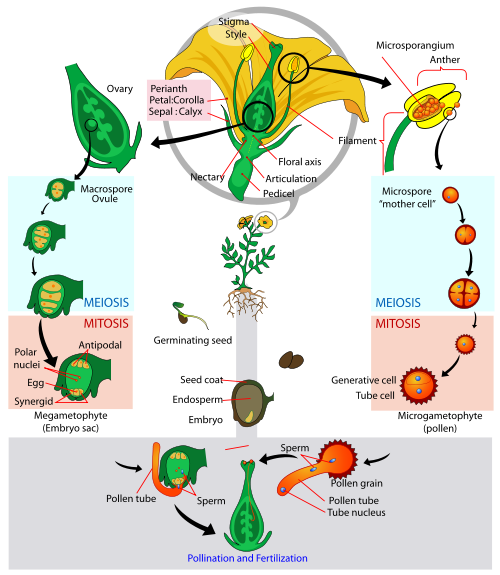Reproduction
Life Cycle of Conium maculatum; an Angiosperm
The photo showed below depicts the process that Conium maculatum goes
through in order to reproduce. Conium maculatum is classified as an angiosperm.
As an angiosperm, this life cycle alternates between that of a diploid sporophyte
generation (2n) and a haploid gametophyte generation (n). This is called an
Angiosperm plants
are considered to be
heterosporous
because they have
two different spores,
the microspore and
megaspore. The male
organs of the plant
(the anthers) contain
diploid spores that are
called microsporocytes.
These microsporocytes
undergo the process of
meiosis in order to divide
and produce
haploid microspores. The female organ of the plant (the carpel) houses a few
different structures such as the ovule, ovary, stigma and style. Within the ovule,
is a single diploid megasporocyte (2n) that divides through the process of meiosis
in order to produce four haploid megaspores. Of those four haploid megaspores,
only one survives.
After each microspore undergoes mitotic division, a pollen grain is produced.
The pollen grain is the haploid, male gametophyte which is called a
microgametophyte (n). The surviving megaspore goes through mitotic division
in order to produce haploid cells that are called megagametophytes (n).
The pollen grain will then work to pollinate the female parts of the flower. This
process starts as a pollen grain lands on the stigma and germinates. A pollen tube
then grows down through the style until it encounters the female gametophyte.
At this point, double fertilization will occur. The sperm will then fertilize the egg
into a diploid zygote (2n) and also fertilize a large cell located in the center that
contains two polar nuclei, into a triploid (3n) cell.
The zygote will then start the next sporophyte generation as it develops into an
embryo. Meanwhile, the triploid cell develops into the endosperm, a necessary
component that provides nutrition for the developing embryo. As the seed
germinates, the sporophyte will mature and start the process all over again.
Another plant that reproduces this way is saw palmetto. Check it out!
Back to Home Forward to Interactions

